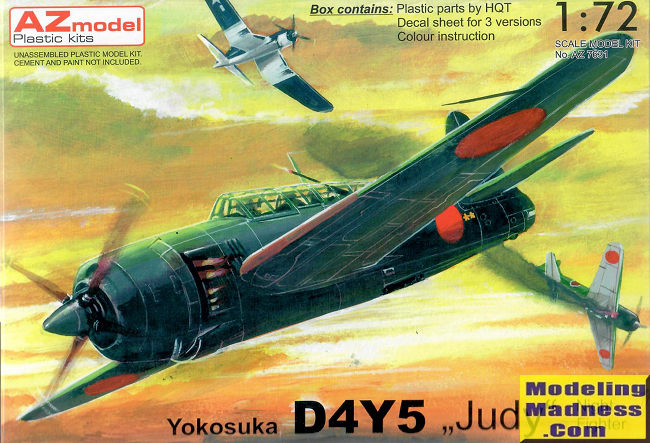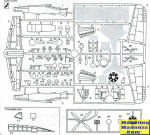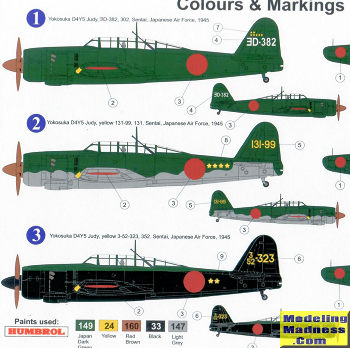
AZ Models 1/72 D4Y5 'Judy'
| KIT #: | AZ 7631 |
| PRICE: | $27.00 |
| DECALS: | Three options |
| REVIEWER: | Tom Hall |
| NOTES: |
Fuzzy what-if concept |

| HISTORY |
As far as we know, the D4Y5 has no history. It was only a concept, and a vague one at that. (It is not even mentioned in Nihon Kōkūki Jiten, an encyclopedia of pre-1946 Japanese aircraft.) We have no idea how it would have looked. Had it been produced, the D4Y5 would possibly have been manufactured by Aichi Kōkūki, or existing D4Y Suisei might have been converted into D4Y5s at a naval air arsenal, if not too challenging a refit. AZ fail to mention its other name, Suisei Model 54 (Five Four). It was to follow the Model 43. Looking at model number “54”, the change of the first digit from 4 to 5 suggests a significant revision of the airframe, compared to the Model 43. That revision can only be imagined. The change of the second digit indicates an engine change, in this case a plan to switch from a 14-cylinder engine, the Mitsubishi Kinsei 62, to an 18-cylinder engine, the Nakajima Homare. That would have raised the horsepower to roughly 2,000.
Unlike AZ, I suspect that the D4Y5 may have been planned as a one-man special-attack airplane, possibly with rocket power for the final dive. (Rockets were experimentally installed on a small number of Model 43s in the last weeks of the war.) I am not aware of any reference that reveals the role that was planned for a D4Y5.
| THE KIT |
 The
kit is a hodgepodge of D4Y parts. It includes the nose for the Suisei Model 12,
which had an inline engine. There is a tail hook for aircraft carrier landings.
AZ has somehow concluded that the D4Y5 would have been a night fighter and
includes the fixed, upward-firing 20 mm cannon of the D4Y2-S, an unlikely
installation for a special-attack bomber. (They did not provide any magazine for
its ammunition.)
The
kit is a hodgepodge of D4Y parts. It includes the nose for the Suisei Model 12,
which had an inline engine. There is a tail hook for aircraft carrier landings.
AZ has somehow concluded that the D4Y5 would have been a night fighter and
includes the fixed, upward-firing 20 mm cannon of the D4Y2-S, an unlikely
installation for a special-attack bomber. (They did not provide any magazine for
its ammunition.)
The fuselage and wings are deceptively similar to those in Fujimi's versions of the D4Y and can almost be interchanged, but they are not identical. For one thing, unlike Fujimi, AZ supplies separate pans for the wheel wells, but they are not much of an improvement over the shallow wheel wells of the Fujimi kits.
AZ provides the front nine cylinders of a Homare engine, along with a 4-bladed prop. They apparently believe that the cowling and ventral air scoop for the Kinsei 62 engine would also have been used for the Homare-powered variant, thereby keeping their mold costs down. Airframe changes for the D4Y5 are not known and are not depicted. AZ assumed that this would have been a two-seat aircraft.
This kit has three separate windscreens, including
two of the simple 3-pane type. AZ expects the modeler to drill a hole in the
beautiful little injection-molded canopy for the barrel of the cannon! Got a
tiny protractor to get that angle right?
The instructions don’t even try to explain the D4Y5. They rule out using certain parts by obscuring them in their drawings of the sprues, but they should also have obscured the exhaust stacks for the inline engine, the front seven cylinders of the Kinsei, as well as cockpit parts 45-47 and steps 16 and 18, which show the flexible machine gun for the dive bomber. There is no evidence that the Model 54 would have been able to land on an aircraft carrier, so the tail hook is surplus, also.
 Decals are for
three naval air units that AZ should have called "kaigun kōkūtai", not "sentai".
For two of the marking options, the aircraft numbers start with "3", indicating
a level/torpedo bomber, which the D4Y was not. AZ’s choice of white for one of
the tail markings is a little iffy for IJN combat units in the second half of
1945. Canary yellow was chosen for the other two decal options, which is closer
to the yellow-orange that was commonly used at the end of the war.
Decals are for
three naval air units that AZ should have called "kaigun kōkūtai", not "sentai".
For two of the marking options, the aircraft numbers start with "3", indicating
a level/torpedo bomber, which the D4Y was not. AZ’s choice of white for one of
the tail markings is a little iffy for IJN combat units in the second half of
1945. Canary yellow was chosen for the other two decal options, which is closer
to the yellow-orange that was commonly used at the end of the war.
| CONCLUSIONS |
To me, this “what If” is sort of a “Who cares?”. Even if I knew what a D4Y5 would have looked like, I don’t see myself building a model of one, so I will put the half of a Homare engine and 4-blade prop into my spares box (a carton that is sure to baffle the executor of my estate). Neither do I see myself boring a hole in the canopy to install a cannon. By keeping things a little simpler and using the nose for the inline engine, I can make a recon version, a D4Y1-C, and scrounge the decals from elsewhere.
| REFERENCES |
Famous Airplanes of the World, No. 69, Bunrindō Co., Ltd., Tōkyō, 1998
Japanese Aero Engines 1910-1945, M. Goodwin & P. Starkings, MMP Books, Sandomierz, Poland, 2017
Nihon Kōkūki Jiten, Model Art Co., Ltd., Tōkyō, 3d printing 1994
March 2021
Copyright ModelingMadness.com. All rights reserved.
If you would like your product reviewed fairly and fairly quickly, please contact the editor or see other details in the Note to Contributors.